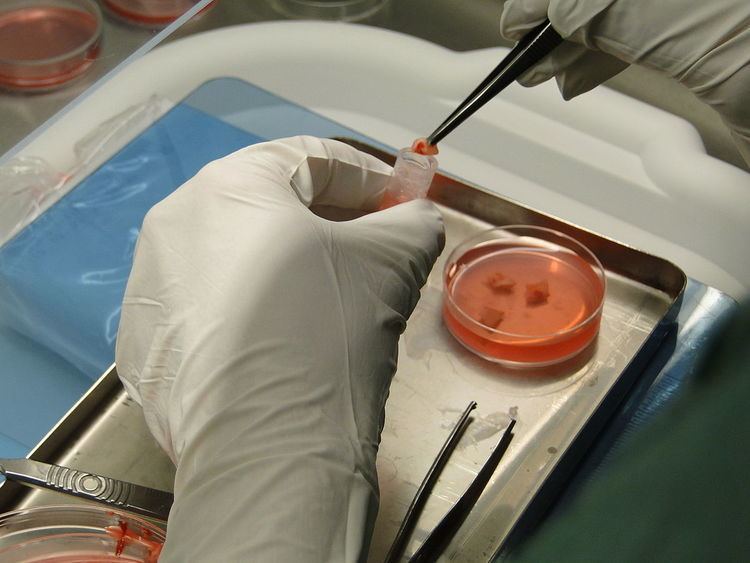 | ||
Ovarian tissue cryopreservation is cryopreservation of tissue of the ovary of a female.
Contents
Indications
Cryopreservation of ovarian tissue is of interest to women who want fertility preservation beyond the natural limit, or whose reproductive potential is threatened by cancer therapy, for example in hematologic malignancies or breast cancer. It can be performed on prepubertal girls at risk for premature ovarian failure, and this procedure is as feasible and safe as comparable operative procedures in children.
Procedure
The procedure is to take a part of the ovary and carry out slow freezing before storing it in liquid nitrogen whilst therapy is undertaken. Tissue can then be thawed and implanted near the fallopian, either orthotopic (on the natural location) or heterotopic (on the abdominal wall), where it starts to produce new eggs, allowing normal conception to take place. A study of 60 procedures concluded that ovarian tissue harvesting appears to be safe. The ovarian tissue may also be transplanted into mice that are immunocompromised (SCID mice) to avoid graft rejection, and tissue can be harvested later when mature follicles have developed.
Strips of cortical ovarian tissue can also be cryopreserved, but it must be re-implanted into the body to allow the encapsulated immature follicles to complete their maturation. Furthermore, ovarian tissue is fragile under hard freezing conditions and putting it back into the body carries the risk of re-introducing cancerous cells.
Risk of cancer recurence
For autotransplantation of cryopreserved ovarian tissue in cancer survivors, metastases have been repeatedly detected in ovarian tissue obtained from patients with leukemia, as well as in one patient with Ewing sarcoma. Ovarian tissue autotransplantation may pose a risk of cancer recurrence in patients with colorectal, gastric and endometrial cancer. However, no metastases have been detected in ovarian tissue from lymphoma and breast cancer patients who have been undergoing ovarian tissue cryopreseration.
History
First ovarian transplant with cryopreserved ovarian tissue was performed by Dr Kutluk Oktay in 1999. In Sep 2004 Prof Donnez of Louvain in Belgium reported the first successful ovarian birth from slow, or controlled rate, frozen ovarian tissue. In 1997 samples of ovarian cortex were taken from a woman with Hodgkin’s lymphoma and cryo-preserved in a rate freezer (Planer, UK)and stored in liquid Nitrogen. Chemotherapy was initiated and after the patient had premature ovarian failure. In 2003, after freeze-thawing, orthotopic autotransplantation of ovarian cortical tissue was done by laparoscopy and five months after reimplantation signs indicated recovery of regular ovulatory cycles. Eleven months after re-implantation a viable intrauterine pregnancy was confirmed, which resulted in a live birth – Tamara. There has, however, been a great deal of controversy surrounding the Louvain claim. Colleagues refute the claims by Donnez, stating that it is not sure whether the mother was indeed infertile.
The first birth following transplantation of ovarian tissue, which has been stored at a central cryo bank after overnight transport, has been achieved by centers of the Fertiprotekt network in Germany 2011. This demonstrated that ovarian tissue can be stored centrally in specialized centers.
